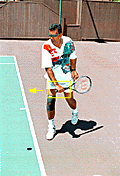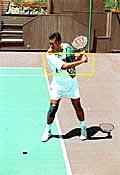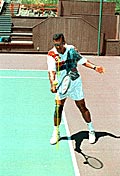TennisOne Lessons
![]()
by Jim McLennan, Senior Editor, TennisONE
To see other articles in the Stow Series, go to:
Part 1, Part
3, Part 4, Part
5, Stow Reprint
[Editor's note: This is part of TennisONE's "Theories of the Game,"
an on-going series of articles covering the greatest theorists--coaches
and players--of the game of tennis. We stand, as been often said, "on
the shoulders of giants." So it's to the giants of the game we must
look to master all the dimensions of the game.]
In the discussion of the teaching methodology of Tom Stow, one always comes
back to the quality of the hit. Tom called it a "conk" for concussion--and
wanted his students to conk the ball. To conk was to hit absolutely
square such that it which generates a special sound and feel
a player learns to hear--and most importantly--feel. And so much
of his system had to do with the "feel."
I personally met Tom after an intercollegiate tennis career, and he suggested
that I hit the ball relatively poorly, for I seldom generated the conk.
And when I tried to swing faster to improve the sound, he would admonish
me that I should swing slower yet hit harder. To do so I had
to meet the ball perfectly. (An aside on the conk. Once when Pancho
Gonzalez was commentating on the 1960's Davis Cup match in Mexico City,
he remarked that Osuna was sure to be a difficult opponent for the upcoming
match because Pancho had been impressed by the sound of Osuna's hits during
practice.)
 |
 |
There is a tricky look to Graf's or Becker's backhand slice. The backswing is unusually high, the racquet swings sharply down and across the ball, and except for the skidding bounce, there is little to be said for the quality of such a hit. When the stroke is elegantly simple, like Rosewall's driving slice, Laver's driving topspin, or Edberg's slice and topspin, the hit and the results are much better.
 |
 |
Now to practice simple. Stand in the ready position with the hands out in front, the elbows lightly bent, and the tip of the racquet at chin height. Now the movement to prepare for the backhand calls for a 90 degree turn of hips and shoulders to the backhand, the body weight precisely shifted to the left foot, posture and balance perfect, the grip changed, and the racquet head slightly moved back. You can move the racquet back by simply turning your hand from handshake vertical to down or horizontal. Absolutely nothing else, don't straighten your elbow, don't raise the racquet above your head (Becker) don't lock your arms with the racquet down by your ankles (Chang), just take it back, and for a model think about McEnroe's backswing.
Since the ideal contact point is at or above the level of the net, this preparation has placed the racquet roughly in that area. And when swinging through from this position either the slice or topspin will be equally conked--providing the contact is out in front, the wrist firm, and the swinging racquet has enough momentum to win the collision. We have several good examples of this "classical" backhand in the TennisONE library, but the pictures of Nigel O'Rourke, head pro at San Francisco's Olympic Club, demonstrates it as well as any (see O'Rourke's complete backhand lesson).
 |
 |
The chipped backhand which is not "conked" is not an offensive
shot (Courier's slice for example). To play an all court forcing game,
the ball must penetrate the opponent's court and shoot through on the
bounce. The photos of O'Rourke demonstrate a Stow-like backhand
slice. Note that the racquet head is higher on the slice than the drive,
but there's no extreme difference. O'Rourke hits a conked, penetrating slice
and you can have similar results when follow the Stow method of classical
simplicity.